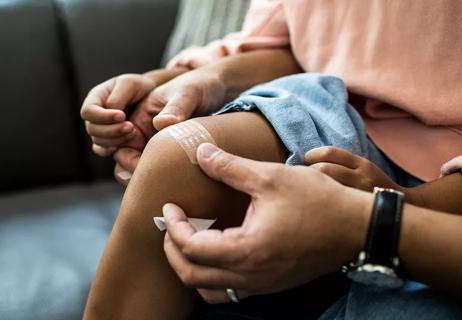Cut up foods into small pieces and make sure you sit down and focus during meals

Toys, keys, random food pieces on the ground — even if you look away for just two seconds, these all end up in your baby’s or toddler’s mouth, one way or another.
Advertisement
Cleveland Clinic is a non-profit academic medical center. Advertising on our site helps support our mission. We do not endorse non-Cleveland Clinic products or services. Policy
It’s all part of their natural exploring stage. And while keeping them safe is your No. 1 priority, sometimes, your child can begin to choke. Choking happens when an object blocks someone’s throat or windpipe, making them unable to breathe.
The leading culprit of injury among small children is something we do every day: Eat food. So, it’s good to know which foods are the biggest choking hazards.
Hard candy causes the most choking episodes, followed by other candy, tough or large chunks of meat and bones. Other high-risk foods include hot dogs, seeds and nuts.
“Parents need to be aware that if their child begins choking on foods like a hot dog, nuts or seeds, they’re much more likely to be hospitalized,” says pediatrician Richard So, MD. “It’s a more dangerous form of choking even though it’s not as common.”
How can you tell if your child is choking? Dr. So explains the signs to look for and what to do if your child is choking.
How can you tell if your child is choking? Look for these signs:
While it can be scary to find your child choking, the first thing you need to do is call 911.
Advertisement
Then, For infants 12 months or younger, instead of reaching into their mouth to search for the object blocking their airway, you should begin backslaps.
Start by turning your child face down so their chest is resting on your forearm. You want to make sure that their head is lower than the rest of their body. To perform a backslap, use the heel of your hand to strike between your child’s shoulder blades. Do this five times, then check their mouth and remove any objects. If their airway is still blocked, try upward chest thrusts.
For children 12 months or older, you should start the Heimlich maneuver. If your child is younger than 5 years old and weighs less than 45 pounds, there’s a modified version of the Heimlich maneuver you should follow.
Hopefully, emergency response care has been able to arrive to assist or take over at this point, too. After the object has been removed, if your child is still having difficulty breathing, take them to the emergency room immediately.
What can you do to prevent your child from choking? Dr. So outlines a few tips to help prevent choking episodes.
In addition to hard candy and hot dogs, there are other foods to keep out of grabbing distance of infants and toddlers, as they’re potential choking hazards.
Those foods include:
So, when can kids have popcorn and other hard-to-eat foods?
Dr. So says those types of food can typically be eaten around 4 years old, when a child has developed their chewing and swallowing skills.
Children of different ages have different needs when it comes to eating. For example, kids under 2 years old don’t have molars, so they can’t grind or crush food.
“Here’s where you really need to be careful with fresh fruits and vegetables like carrots that are very fibrous,” advises Dr. So. “Once your child turns 2, they may have all their teeth, but may still have trouble swallowing different foods. Different shapes, sizes and textures can increase choking risks and this can be a concern up to age 5.”
Food size is important. Cut your child’s food into pieces small enough so they can’t get stuck in their throat. And only give them a few pieces at a time.
“The best size is about a quarter of the diameter of a hot dog or large carrot,” instructs Dr. So. “It’s also a good idea to cut the food into triangular shapes to allow air to pass just in case the food does get caught in the child’s throat. For grapes, try cutting them into disks.”
Advertisement
Teach your child to swallow their food before they start talking or laughing to decrease their chances of choking. Kids at any age, particularly small children, should be sitting down when they eat — even when they’re eating candy. It’s important to supervise and make sure they’re not eating while they’re lying down either.
“Make sure they chew thoroughly,” states Dr. So. “Don’t let them run around and play with food in their mouths. When kids sit and focus on what they’re doing, the risk of choking goes down significantly.”
Taking these necessary precautions goes a long way in preventing your child from choking.
“While accidents still happen, be prepared to act fast during an emergency by learning cardiopulmonary resuscitation (CPR),” advises Dr. So. “If your child was choking but then becomes unconscious and is no longer breathing, you may need to start CPR while waiting for emergency medical services to arrive.”
Advertisement
Learn more about our editorial process.
Advertisement

Your baby needs to able to roll in both directions before they can make the switch

They’re nontoxic, but crayons can cause an upset stomach and pose a serious choking hazard

Quick action and proper care can make a big difference

When disasters or emergencies happen, make sure your family is prepared

Bleeding is a risk and warrants taking care, but the reward of this lifesaving medication is great

Type 2 diabetes isn’t inevitable with these dietary changes

Applying a hot or cold compress can help with pain